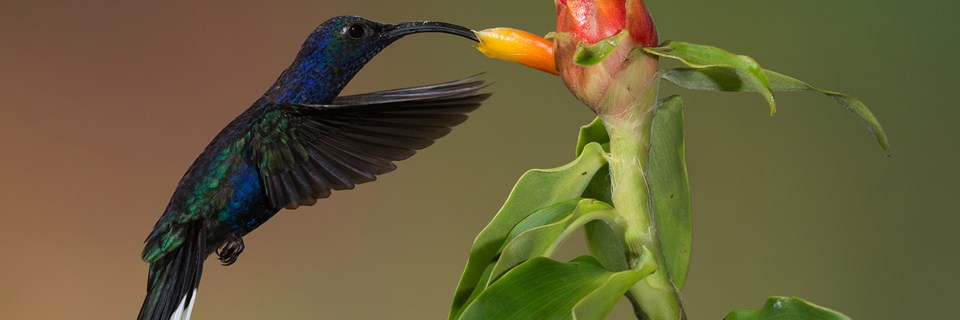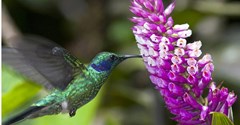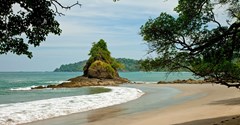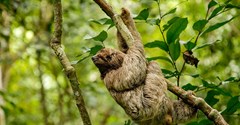Considering a Costa Rica birdwatching holiday? Discover some of its most beautiful birds and the best places to see them in their natural habitats.
Costa Rica is a bird lover's paradise, with a huge variety of national parks and different habitats for experienced pros and novices alike to experience the richness and variety found here. Throughout the country you will encounter exotic songbirds, graceful waterbirds, powerful birds of prey and a huge variety of hummingbirds. To whet your appetite, we present a small cross-section of the country's seemingly endless variety of bird species, some common and others elusive, and indicate where they have been reliably sighted in Costa Rica's most popular birdwatching places.
Sightings key: Ar = Arenal, CV = Corcovado, MA = Manuel Antonio, PV = Palo Verde, TO = Tortuguero.
A - Amazon Kingfisher
The Amazon Kingfisher can be identified by their oversized bills and are can often be seen perched on tree branches near streams, lakes and rivers, their principal feeding grounds. They can sometimes be spotted hovering above the water, fixing their sights on their pray before diving in head first for the kill. Their plumage is dark green and males sport a more eye-catching chestnut-coloured patch on their breast. They are one several species of kingfishers with whom they share their habitats in Mexico, Central America and the wetlands of Northern Argentina and Southern Brazil.
Sighted in: AR, CV, MA, TO
B - Broad-billed Motmot
Slightly smaller in size than others, this variety of motmot can be found year round as far south as Bolivia and as far north as Honduras, typically in humid lowland forests. The bird catches the eye with its colourful plumage, squat appearance and long distinctive tails, said to resemble a pendulum. Their diet consists largely of insects and small reptiles, caught on short forays. Between feeding they often sit for long periods without moving, making them slightly easier to see. Other motmots which live in Costa Rica include the wide-spread lesson's and turquoise-browed varieties, the keel-billed and rufuous species, both of which could be spotted in Arenal.
Sighted in: AR, MV, TO
C - Crested Guan
These loud members of the sub-canopy can be found across Central America and the upper reaches of Colombia, Ecuador and Venezuela. The crested guan bears more than a passing resemblance to a turkey, though its most identifiable features are the bright red wattle and its mohawk-style black crest. They are usually seen in pairs or small groups foraging for fruit and berries along branches, coming down occasionally to find water.
Sighted in: AR, CV, MV, PV, TO
D - Double-toothed Kite
This distinctive bird of prey is so named for its two 'teeth' in its bill and lives throughout Central American and tropical areas of South America. The kites spend much of their time in the middle canopy, diving to the ground to swoop for unsuspecting prey, following groups of monkeys disturbing smaller creatures or sometimes soaring high above the trees in the skies, though surprisingly not for hunting purposes.
Sighted in: AR, CV, MA, MV, PV, TO
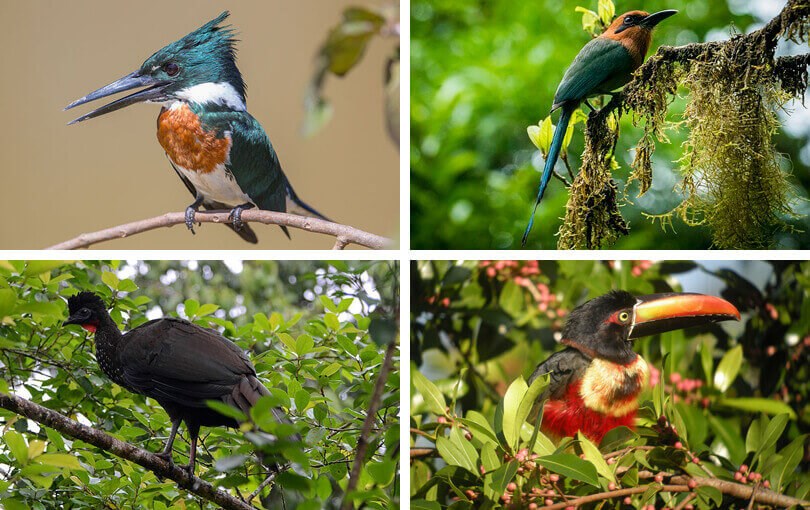
Clockwise: Amazon kingfisher (Andreas Trepte), Broad-billed motmot (Beckerdigital), fiery-billed aracari (Frank Vassen), Crested guan (Geoff Gallice),
E - Eastern Wood Pewee
This small flycatcher, which migrates down to Central and South America from North America, is visually unremarkable, with primarily grey plumage. What makes them of interest to travellers is the sound which they release when singing; a high pitched 'pewee' for which they are so named and which can be heard piercing the background sounds of the forest throughout the day. They are often found on small branches and hunt mainly flying insects.
Sighted in: CV, MV, PV, TO
F - Fiery-billed Aracari
Aracaries are medium-sized toucans, with the same charismatic bills, big round eyes and colourful feathers and, like their larger relatives, are among the more active and energetic birds of the rainforest. One glance at the fiery-billed aracari, native to Costa Rica, and it's not difficult to see where it gets its name from. Collared aracaries are also known to reside in Arenal, Tortuguero and Palo Verde National Park.
Sighted in: AR, CV, MA, MV
G - Green Honeycreeper
These brilliantly coloured tanagers thrive year-round in humid rainforest in tropical Central and South American countries. Males have a turquoise blue hue, compared to females which are green in colour, though both share the distinctive yellow/black decurved bill and piercing red eyes. They are often seen flitting back and forth to bring food, mainly fruit but also some small insects, to their open nests in the canopy.
Sighted in: AR, CV, MA, TO
H - Harpy Eagle
Corcovado on the Osa Peninsula and Tortuguero on the Caribbean coast are the places to go in Costa Rica if you want to stand a chance of glimpsing the largest raptor in the Americas, though those that do get a sighting should consider themselves extremely fortunate given its rarity in Central America. Their distribution is currently thought to stretch from the south of Brazil up towards Guatemala and Belize, where numbers are more sparse. Costa Rica is home to a number of other eagle species, particularly in Corcovado, where six different varieties have been recorded. The most common are probably black-hawk and ornate hawk.
Sighted in: CV, TO

Clockwise: Green honeycreeper (Andrew Morffew), Harpy eagle (Brian Gratwicke), Jabiru stork (Rodger Evans), Indigo bunting (USFWSmidwest)
I - Indigo Bunting
Another tiny bundle of colour, the Indian bunting is a small songbird that is widespread in Mexico and Central America as it migrates south to warmer climes in the winter. The species gets its name from the fetching indigo plumage sported by the males during breeding season and emits a cheerful, crisp and lively song.
Sighted in: AR, MV, PV, TO
J - Jabiru Stork
Those planning to spend a few days relaxing on the golden Pacific beaches of Guanacaste might like to consider a day trip to the nearby Palo Verde National Park, another wildlife haven in which you can spot a huge variety of birds, including many featured here. Of all the major wildlife destinations in Costa Rica, Palo Verde gives you the best chance to see jabiru storks up close, though even here they are considered quite rare. The storks feed near rivers, shallow lakes and ponds and are actually more typical of wetland areas, such as the Pantanal in Brazil or Ibera in Argentina. They are distinguished by the flash of red on their necks and typical long bills. More wide-spread are wood storks, which can be seen in most of the major wildlife destinations featured here.
Sighted in: PV
K - Keel-billed toucans
One of the most charasmatic and photogenic bird species in all of the Americas, the keel-billed toucan is instantly recognisable and guaranteed to bring a smile to the face of any visitor. It's oversized curved keratin bill, big bold eyes and vibrant tropical colourings create an immensely endearing appearance. Seeing them gather in family groups and sometimes tossing fruit to each other using their bills is one of the vivid sights of the tropical rainforest. Other widely seen toucans in Costa Rica include the yellow-throated and northern emerald varieties. The former sports a distinctive black and yellow bill, whilst the latter is smaller in stature and green in colour.
Sighted in: AR, CV, MV, TO
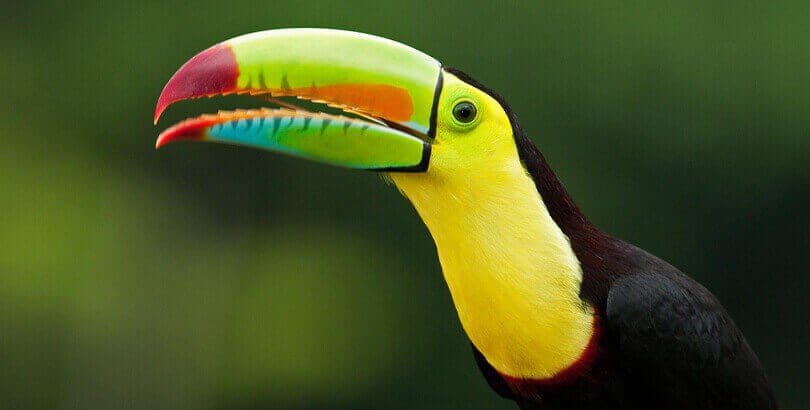
Killed-billed toucan
L - Long-tailed Manakin
Spot a long-tailed male manakin in the wet forests of Costa Rica and you'll be left in no doubt as to its defining feature, from which it gets its name. Two elongated feathers extend from its black plumage to create twin tails, which hang elegantly from its relatively small body. A distinctive red crown on top of its head and a bright blue patch on its back complete a flamboyant look. The long-tailed manakins are distributed throughout Central America and the Monteverde Cloud Forest and the Carara National Park near San Jose are two of the few places to see them in Costa Rica.
Sighted in: MV, PV
M - Magnificent Frigatebird
Identified in flight by it's large bat-like black wings, arrow-like tail and long curved bill, the magnificent frigatebird is a graceful and agile seabird which can be spotted near the coast lines of Costa Rica, particularly in the Corcovado National Park. Perhaps the most distinctive feature of the species is the bright red gular sac sported by males, which inflates in an eye-catching though rather ungainly fashion in the breeding season. The magnificent frigatebird is also commonly found in the Galapagos Islands.
Sighted in: AR, CV, MA, MV, PV, TO
N - Northern Jacana
The long spindly legs and vibrant yellow bill and wattle make the northern jacana a curious creature, often found in the marsh ponds and shallow lakes of wetland areas. Their enormous toes and legs are specially adapted to allow them to traverse lily pads in search of small insects. They are distributed throughout Central America and the Caribbean, with Tortuguero being the best place to see them in large numbers in Costa Rica.
Sighted in: AR, CV, MA, PV, TO
O - Orange-bellied Trogon
Found only in central highland areas of Costa Rica and neighbouring Panama, the orange-bellied trogon is an attractive bird, distinguished by its squat emerald green head, fetching striped underpattern and, of course, its signature orange belly (more vibrant in males). They are often found perched quietly on the branches of trees in humid forests and differ from the more widespread collared trogon in only the colour of their belly. This variety can also be found in Monteverde.
Sighted in: AR, MV
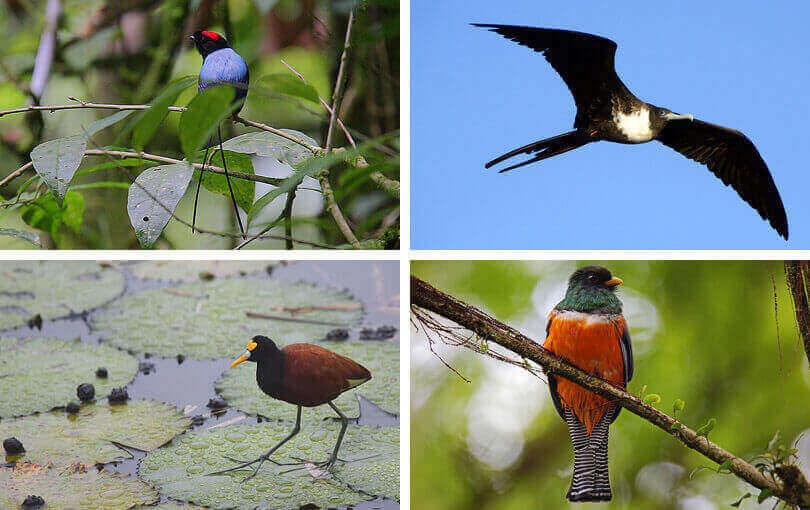
Clockwise: Long-tailed manakin (Steve Garvie), Magnificent frigatebird (Putneymark), Orange-bellied trogon (vil.sandi), Northern jacana (Andy Reago & Chrissy McClarren)
P - Pale-billed Woodpecker
The most striking of the many varieties of woodpeckers that are widespread in Costa Rica is the pale-billed species. The punk rocker-style bright red crest stands out against the verdant hues of the forests in which they reside, particularly for males for whom the red markings continue over the entirety of their heads. Other variations of woodpeckers sighted in the birdwatching areas featured here include golden-naped, golden-olive, hoffman's, lineated, rufuous-winged, smokey-borwn and red-crested.
Sighted in: AR, CV, MA, MV, PV, TO
Q - Quetzal
One of the most glorious creatures of the Americas, the resplendent quetzal was revered by the Mayans and Aztecs, who considered it sacred and treasured its magnificent feathers. During the mating season the vibrant males grow long tails, up to one metre in length, creating an appearance that not only impresses female quetzals, but humans too. The quetzal has sadly suffered at the hands of poachers, whilst also seeing much of its natural habitat shrink, threatening its existence. But Costa Rica has preserved protected areas in which it can flourish and be observed by eco-tourists, particularly in Arenal and Monteverde. Perhaps though the best place to see a resplendent quetzal in Costa Rica is in the place named after the bird itself, the Parque Nacional Los Quetzales, located between Manuel Antonio and San Jose in the south of the country.
Sighted in: AR, MV
R - Rufous-tailed Jacamar
The same sword-like bill, vibrant plumage and diminutive stature give the jacamar more than a passing resemblance to a hummingbird. Aside from its greater size, what differentiates them in a major way is their behaviour in gathering sustenance. Whereas hummers furiously flap their wings at mind-boggling speeds and hover mid air, forever darting back and forth, jacamars tend to take the easier approach of sitting still on branches and using their long bills to catch passing flying insects and butterflies. They are another species that can be found in several Central American countries, as well as in Ecuador and Brazil.
Sighted in: AR, CV, MV, TO
S - Scarlet Macaw
Whether you are destined for the Amazon Lodges of Peru or the tropical forests of Costa Rica, one bird high up on your sighting wishlist will be the magnificent scarlet macaw. A particularly majestic sight is that of a pair of scarlet macaws in graceful flight or perched happily against the deep blue sky and lush vegetation of the canopy. The world's biggest parrot is also one of the most eye-catching, playful and audible creatures of the rain forest. It resides in lowland areas up to around 500 metres, though the great green macaw has also been sighted in Monteverde.
Sighted in: CV, MA, PV, TO
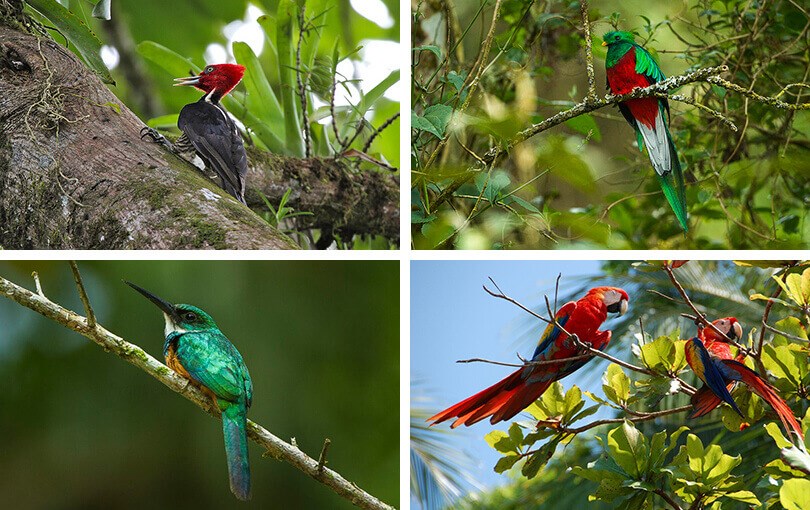
Clockwise: Pale-billed woodpecker (Juan Zamora), Resplendent Quetzal (Francesco Veronesi), Scarlet Macaws (Casa Corcovado), Rufuos-tailed jacamar (Francesco Veronesi)
T - Tricolored Heron
Usually found in swampy habitats, mangrove lagoons and along remote beaches, this graceful waterbird gets its name from the attractive mix of hues, complemented by its long yellow and dark grey bill and yellow legs and feet. They are normally spotted in shallow water, either slowly stalking prey or standing still and waiting for their food to come to them. Of the major protected wildlife areas, they are most abundantly observed traversing the waterways of Tortuguero. Other types of heron are common in Costa Rica's national parks, such as green, great blue, little blue, yellow-crowned and boat-billed.
Sighted in: CV, MA, PV, TO
U - Uniform Crake
Part of the rallidae family, this reclusive bird is at home in marshy swamps and wet forests and foraging for small insects and lizards. It is found throughout the tropical regions of Latin America, though more often than not it is heard but not seen thanks to its loud calls. Those that do catch a glimpse of a uniform crake will recognise it for its dark rufous coat and spindly red legs.
Sighted in: AR, CV
V - Violet Sabrewing Hummingbird
Seeing a hummingbird up close for the first time is a memory that will stay with even the most experienced of bird enthusiasts. The sight of their wings flapping furiously, too fast for the human eye to keep apace with, juxtaposed against their motionless body, serene disposition and the accuracy with which they direct their long bills towards the nectar is an example of nature at its best. The violet sabrewing is one of the largest hummingbird species and is noted for its vibrant plumage and slightly curved bill, finished with a white tip. A huge number of hummingbird varieties live in Costa Rica, with a large diversity found in the Monteverde Cloud Forest in particular. Of course another great place to see them up close is the La Paz Waterfall Gardens near the capital San Jose.
Sighted in: AR, CV, MV, TO
W - White-throated Shrike-Tanager
This colourful character is most commonly found in wet tropical and subtropical forests in Costa Rica and neighbouring Central American countries. Often perched stock-still in the middle canopies of tall trees, it springs into life to catch flying insects as they pass. This variety of tanager sports a bold yellow chest, with layers of sporty-looking black and dark grey feathers covering its back and forming a long tail. It is just one of large number of tanagers in Costa Rica.
Sighted in: CV, MA
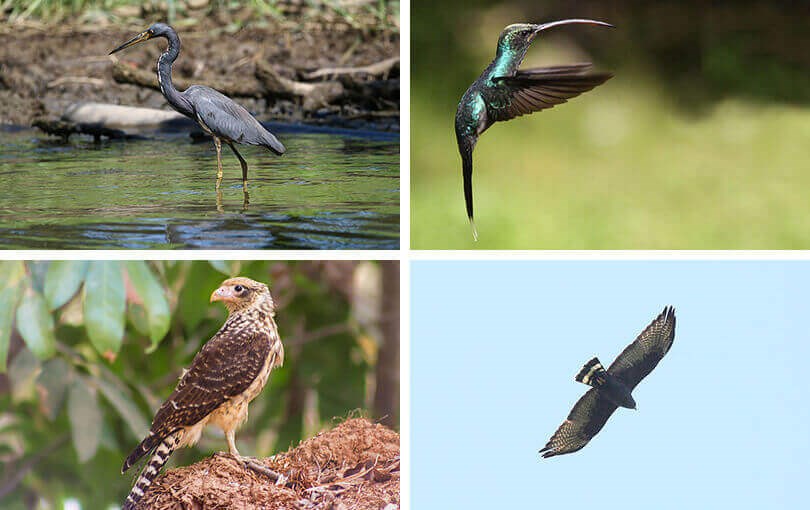
Clockwise: Tricolored Heron (Christian Mehlführer), Violet Sabrewing (Charlesjsharp), Zone-tailed hawk (Dominic Sherony), Yellow-headed caracara (Fernando Flores)
X - Xenops
Found in moist lowland forest, these small birds can sometimes be seen chipping away at tree barks with its beak, woodpecker style, or even hanging at awkward angles using its feet to wrap around branches. The plain xenop can be spied in Arenal, Corcovado, Manuel Antonio and Tortuguero, though its largely rufous plumage can make it tricky to distinguish between the branches and trunks. Streaked xenops are more attractive because of the intricate white markings which give the species its name. These have been sighted in Manuel Antonio
Sighted in: AR, CV, MA, TO
Y - Yellow-headed Caracara
The range of this bird of prey is largely South America, though reaches slightly into Central America. Unusually on this list, the yellow-headed caracara extends all the way down to Uruguay and inhabits diverse habitats, including savanna, grassland, marshes and tropical forest. Largely pale yellow and dark brown in appearance, they differ from many other birds of prey in that they largely feed by foraging on the forest floor.
Sighted in: CV, MA, MV
Z - Zone-tailed Hawk
This majestic hawk has a wingspan of up to four feet, under which is presents a distinctive striped underpattern with characteristic grey feathers flaring out at the extremes. When flying, the zone-tailed hawk is thought to bear a close resemblance to a turkey vulture, a feature it uses to its advantage by sneaking up to unsuspecting prey who would not otherwise be threatened by the presence of its lookalike. They are also known to perform spectacular courtship displays, plummeting from heights of 500 metres and looping back up in an act of prowess and bravery.
Sighted in: AR, CV, MV, PV
Want to experience Costa Rica's extraordinary bio-diversity for yourself? Browse our selection of Costa Rica holidays below, all of which include some combination of the places featured here, or give us a call or send us an email to begin discussing your plans in more detail.
Choose your perfect holiday
Find inspiration from our selection of itinerary suggestions, a great starting point for your next trip
View More Tours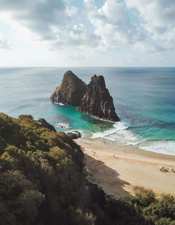
Stay in touch
Infuse your travels, with inspiration from our monthly newsletter.
READY - 20 April 2024
LANDMARK TOURS: Multi-Country & Cross Continent. New Cosmopolitan Tour: Buenos Aires, Iguazu, Rio
CHINA & INDIA: Local Life, People & Unique Cultures
GUIDES by Veloso Tours, are the best Local Hosts
PRIVATE VILLAS: Quality Time in exclusive settings
TRAVEL INSURANCE with extensive COVID-19 cover
